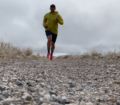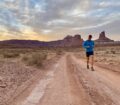![]() This article is sponsored by Gu Energy.
This article is sponsored by Gu Energy.
Like many on the TAUR team, I have been running ultras for a few years. The past 10 years, I have loved learning about trail and ultra running as well as my own competencies and short falls. It has taken a very long time to learn the ropes of trail and ultra running. To my surprise, despite the assumption of an aging body, my fastest years are not behind me. Last year I PR’d in the 1 mile, 5k, and numerous staple regional races. Unfortunately, the speed work has not translated to significantly improved times on the ultras.
In February, while running the Antelope Canyon 50 miler, I enjoyed a lovely 20 miles at a casual pace, followed – in some part to my poor training – with a much slower back end 20 miles. Many contributing factors impacted this noticeable decline in pace, such as training, conditions, previous injuries, and nutrition.
Regrettably, my racing history is plagued with this common narrative. In an effort to poorly use hyperbole, I’ll liken myself to a high performance vehicle. Sometimes imagining a Porsche, Ferrari or 67 Stingray Corvette, I race out of the gates at a blistering pace. Don’t get me wrong, I’m still within my limits, it’s not anything I haven’t trained for, and I can still hold a conversation. I typically enjoy the first 20-30 miles of most races. These painless miles are always followed by ‘the suffering’. This looks much like when these performances race cars run out of gas in the middle of the track. Ultimately, several large men are needed to push my barely cognizant corpse into the pit area for a long replenishment. Or I sputter on as numbingly slow paces for the remainder of the race.

Not me
Some of my closest friends joke adamantly that only if I trained better or monitored my progress more effectively I might actually accomplish something. Typically, I brush this aside with my aspirations of not actually accomplishing anything.
That was until some recent conversations with GU.
When our friends at GU approached me this fall to discuss their upcoming Nutrition planning tools, I knew I would be an excellent case study. Yes, thats right. Coming soon, GU will not only be providing a variety of nutritional options for endurance athletes, but a planning process for specific race distances and events.
The GU team, along with a fantastic conversation with Magda Boulet, helped me understand the need for a balanced replenishment of Calories, Electrolytes, Amino Acids and fluids while racing and training. During our discussion, Madga explained the rationale for each of these elements and the guiding principals of Digestion, Blood Supply, Food composition and Psychosomatic aspects of digestion.
One over arching theme that greatly impressed me was how much their team was really trying to help me to optimize my own personal experience. Hopefully this optimization will translate into better times, but more importantly into a better and more satisfying running experience.

The team inquired into my normal nutrition for a 50 miler. As we discussed, I saw some obvious discrepancies and deficiencies with my existing nutrition plans. Specifically, how I was deficient in my consumption of Calories and Amino Acids. After detailing out what would be feasible for me at the upcoming TNF San Franscico 50 miler in December, I felt more confident in addressing my typical narrative experience.
While, I can’t yet share the details of the Nutrition future with GU (and what exciting that will bring for the upcoming year), I can share how even this brief introduction has given me some excitement and enthusiasm about my upcoming race in December.





















